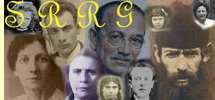Helen's Family Photo Album 1937-1939
Helen was about 19 when she acquired a camera and in so doing became the official family photographer. Not only are these pictures a visual chronicle of us during this period, but it became a "window" through which I viewed my older siblings when they were younger and at home.
There are photos of Frankie and me, too, some with our brothers and sister taken when we were too young to realize that we were included. Our family is made up of three periods. The first four children were born between 1916-1922-all two years apart. There was a 7-year span before Frankie was born, 1929 and then two years later I arrived. Our baby brother, Charles, was born 9 years after me (1941). Sid and I are 16 years apart. Sid and Chuck are 25. Helen's unique album made it possible for Frankie and me to know something about our older siblings when they were young-what they looked like, what they were doing.
|
|
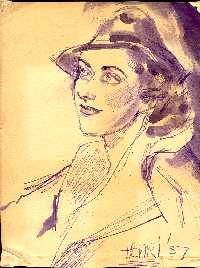
As the artist saw me
|
Because the boys were away at college and or in the War, we would not have known much about the first 4 children. Through these pictures we perceived our family as as we saw them--happy, well-dressed, and having fun. Until we were older, Frankie and I had no idea what the Depression was about.

|
|
Helen was artistic. During the war she would draw comic strip characters such as Li'l Abner on the envelopes of letters she wrote to her husband Will Fingerhut. Their first apartment after the war, was cozy and charming because of Helen's creative touches.
The choice of professions for women was still narrow with the exception of teaching and nursing. Helen thought she wanted to become a nurse but few Jews were accepted. Lena went about doing what she could to help Helen. She contacted the "support group" and eventually Helen was accepted to St Vincent's hospital. Her training was in the children's ward--the same one where Stan had been treated five years earlier. But after six months of hard hospital duties, Helen left, finding the reality of the work and environment not to her liking. She thought of women's fashion design, but that probably would have required training at a school of design. Finding money for this was beyond our parents' means.
|
"Lolly", the name I called Helen, found work in a retail store selling cosmetics. During the Depression, women felt lucky to be employed by a fine, established department store.
I was 5 years old now, probably running after Frankie and his friends. There were no store-bought toys so we made do with what was available and didn't know the difference. We had a large buckeye tree on the front lawn (state tree for Ohio). In the summers we would spend our time collecting the thorny green nuts, (stored them in grocery bags), which we carefully peeled to reveal the shiny, smooth, brown chestnut-like nuts. In the spring, the regal trees showed off their beautiful pink or white flowers. Playing under the house foundation was another way I passed the day, the lattice screen needing repair provided an opening. That was my hide-a-way. According to the album of pictures, I had a tricycle and an Indian-dress costume. As part of such a large family, we played on our own, never wanting to bother our parents, particularly our mother, who had so much to do in her role as parent and housewife. (I use the term housewife in the context society used to define unsalaried women who worked at home.)
|
|
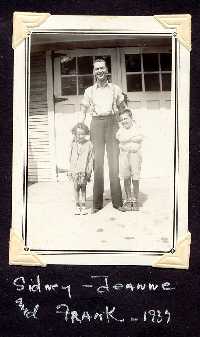
|
Stanford
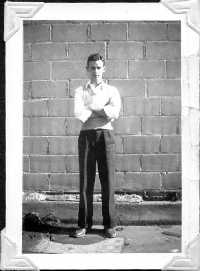
|
|
To earn money, Stanford, age 17, joined the naval reserves. He also worked part time for Pinkas Engineering, a small firm whose owner eventually became Stan's mentor. Always studying in his room, Stan was focused and worked hard to achieve high grades. He was handsome, brilliant, sensitive, and introverted-mostly shy. Stan was hospitalized for 6 months in his younger, formative years and I am sure that affected his self image. Also, he was born left handed but at that time, teachers forced left-handed students to use their right hand which was an unnerving experience for Stan.
Frankie tells me Stan and Sid worked summers for a program called CCC, Civilian Conservation Corps of the 1930s.
|
Philip
Phil recently related a fond memory of his younger youth during the rough years of the Depression.
We were living on Vermont Street Phil recalls (behind Franklin Avenue, close to Page Street). During the summers, once a week one of the neighbors, Mr. Siegel, a delivery man for the Feldman Bakery, drove home to pick up his son Joey and several of his neighborhorhood friends, including Phil. The plan was to drive to a public swimming pool at Willys Park (a distance from home), located out towards the Willys Overland auto factory. As the children jumped into the truck, their smelling senses were over powered by the incredible aroma of freshly-baked rolls from Feldmans Mr. Siegel brought along and fresh vegetables that included raddishes, onions, tomatoes and other sandwich delectables. And as if these delights weren't enough to create wild excitement among the boys, one more topped off the spectacular afternoon. As Mr. Siegel began driving away, his dog "Sport", waiting in the street close by, ran along the side of the truck and as if trained for this stunt, jumped up onto the running board in perfect timing, where he remained seated (without a seat belt) for the ride of his life!
About age 14, Phil was in the eighth grade at Fulton Elementary School. Miss Marjorie Johnson was both the art and music teacher and what a gifted person she was. For the 1937 8th Grade Spring performance, she took on the ambitious task of presenting (in marionette form) Gilbert and Sullivan's operetta, "The Mikado" and it became a year's project. Her two art classes participated-the students molded clay faces for the marionettes, sewed costumes, and worked on the overall production. In addition, the students in Ms Johnson's 8th Grade Glee Club acted and sang the parts, such as Phil who was chosen to play the part of "Nanki-Poo". Thus began Phil's childhood dream to be in theater.
Troop 37 sponsored by the reform Collingwood Avenue Temple was Phil's window of opportunity, you might say. There he met boys whose families were in a high socio-economic tier of the Jewish community. For the first time he saw the difference of being poor with those who lived on the other side of the tracks. Phil, good looking, charming, with a winning personality, became good friends with some of the boys and he was noticed by the troop leader who took a special interest in him. He arranged for Phil to work as a life guard at a country club where Phil made many friendships.
|
|
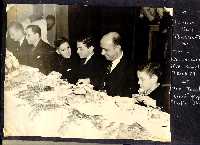
|
The boyscout years for Phil was the most profound influence in his life and he is still proud of the fact that he worked and achieved the highest level of scouting called Palm scout. He entered the scouts when he was about 12 and remained there until he graduated high school at the age of 18. His scout mentor, one year older, was Ebbie Epstein who coached Phil during his first year of scouting.
Phil had been studying the trumpet at this time. One of Sid's friend owned a small bugle he was selling for $10. ($10.00 in 1937 would cost $122.96 in 2001)(13) With the money Phil saved from selling shoes, he bought the small instrument which he loved and it became a part of him for the rest of his life. The bugle traveled every he went, opening opportunities in his young life to perform as a bugler for: the scouts, shofar at the Collingwood Avenue Temple, first trumpeter in the Scott High school orchestra, bugler for the army band (he awakened the troops), trumpeter for the airforce cadets, airforce entertainment shows, and then later in his act as a nightclub entertainer. He continues to practice his trumpet and bugle every day.
|
|
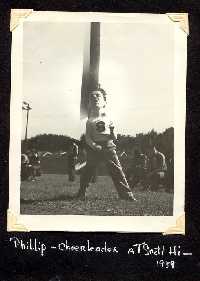
|
Frankie
In 1937, I was 2-1/2 years older than Jeanne and in the second grade. My interests in school (I attended Fulton School, too) were limited, except for music, which showed up early in my life. I always received good grades in music and was in the Fulton School Glee Club in the 7th and 8th grade years at the school.
I was outside in the neighborhood playing with my friend, Frederick (Freddy) Seibert, who lived across the street from us on Putnam Street, and a new friend I had met, Thomas (Tommy) Ungerlider, the grandson of the Levinson family, also living across the street from us. Of course, there were many more friends, but these two boys were very close to me, spending a great deal of time with them. I would spend one week in the summertime with Freddy at their Howard Farms, Ohio, cottage each summer on Lake Erie, swimming and playing. When Tommy came to visit Toledo in the summer from Florida, his grandfather, Harry Levinson, a prominent Toledo lawyer, would take us to movies, downtown to his office and play with us and do magic tricks. One night I listened to the Joe Lewis/ Gene Tunney fight in 1937 and remember how the “brown bomber” floored Tunney in the first round.
I would travel the neighborhood to play baseball, ride bikes, play games, go sledding and play hide and seek with many of my neighboorhood friends. To make money for movies, ice cream or candy, I sold newspapers (The Toledo News Bee) and magazines in the neighborhood. I was resourceful in that regard, because I realized that I had to do those things to avoid asking my parents for money.
I spent many hours at the radio, listening to the “Green Hornet,” a popular children’s show each day. I also recall hearing Hitler speeches in German and listening to Father Coughlin on Sundays preaching Fascist and anti-Semitic rhetoric to his flock. This varied assortment of entertainment, (Freddy Seibert once called me a “kike”) was bewildering, and when I asked him, what that meant, Freddy replied that he didn't know, but that his father had told him all Jews were kikes. These years were perplexing, indeed, very little money, the world events changing before our eyes, yet life was truly beautiful in the U.S. What a contrast!
Sidney, Stanford and Philip were my idols, to whom I looked up to as role models. Sidney was in college at this time, but I was closet to Philip, spending much time with him then. I even went to a father-and-Son Banquet with Philip, where he was shepherded by Mr. Michaels, of Troop 37, as his surrogate father. I recall Stanford and Phillip practicing for their merit badges in “flying”, “Fire-by-Friction” and several others. They always worked together as members of Troop 37 and both became Eagle Scouts. I looked forward to reaching their goals.
|

